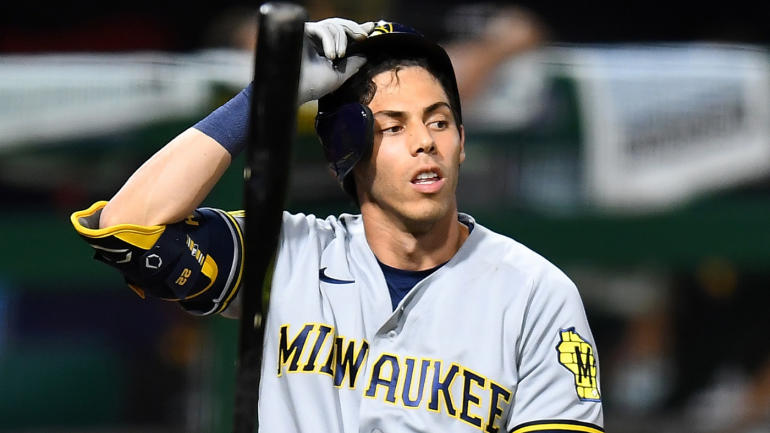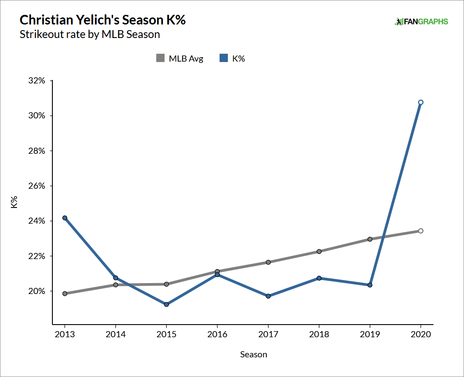
Pitchers and catchers have reported to spring training and the long journey that is the 2021 MLB season has begun. The ongoing pandemic means it will be challenging, but MLB and the MLBPA believe they're up to the task of playing a full season, so let's hope they can do that without interruption. I've missed baseball terribly.
Last year's abbreviated 60-game season brought unexpected performances, good and bad. Who had Kenta Maeda posting the lowest WHIP among qualified starters? What about Javier Baez putting up the third-worst OPS in baseball? Can't say I saw any of that coming. Weird things happen in 60-game samples and the other 102 games weren't available to normalize things.
With that in mind, let's look at five players who had disappointing 2020 seasons and are primed for a rebound in 2021. We're going to ignore players who missed a bunch of time with injuries (like Stephen Strasburg) and instead focus on players who were largely healthy and simply didn't play up to their standards. The players are listed alphabetically.
1. Pete Alonso, Mets
The narrative is so easy it's almost lazy. Hot-shot rookie has a historic debut season, then he struggles through his second year in the big leagues, so bam, sophomore slump. Pitchers adjusted, the player put too much pressure on himself, whatever. We could come up with countless unquantifiable ways to explain a disappointing second season, like Mets slugger Pete Alonso's.
"I wouldn't call it pressure. The uncertainty got to me mentally," Alonso recently told the New York Post's Steve Serby about his struggles last year. "Last season, I failed more than any time in my career, and that simply won't happen again because of my preparation and will to succeed."
In a lot of ways, Alonso's underwhelming sophomore season mirrored his spectacular rookie campaign. His surface stats didn't match up at all -- Alonso hit .231/.326/.490 in 2020 after putting up a .260/.358/.583 line in 2019 -- but the underlying numbers were almost identical. Check it out:
| Strikeout rate | Walk rate | Exit velocity | Hard-hit rate | Chase rate | In-zone swing rate | |
|---|---|---|---|---|---|---|
2019 | 26.4% | 10.4% | 90.7 mph | 42.7% | 32.4% | 65.0% |
2020 | 25.5% | 10.0% | 90.2 mph | 41.2% | 31.4% | 63.2% |
Alonso still hit the snot out of the ball (hard-hit rate is percent of batted balls with at least a 95 mph exit velocity), he didn't strike out more or walk less, and his swing decisions in general were the same. He didn't chase pitches out of the zone more frequently nor did he swing less often at pitches in the zone.
Under the hood, 2020 Alonso looked a lot like 2019 Alonso. He did trade a few line drives for pop-ups last year, though not enough to explain 29-point drop in batting average and a 93-point drop in slugging percentage. More than anything, Alonso fell victim to the shift in 2020. Opponents more aggressively shifted their defense against him and his production suffered.
| Percent plate appearances | Batting average | Batting average on balls in play | |
|---|---|---|---|
2019 no shift | 27.6% | .263 | .262 |
2020 no shift | 17.2% | .275 | .268 |
| Percent plate appearances | Batting average | Batting average on balls in play | |
2019 with shift | 25.0% | .304 | .301 |
2020 with shift | 38.1% | .231 | .231 |
When opponents did not shift against Alonso, he was the same basic hitter in 2020 as 2019. He saw considerably more shifts in 2020 though, and he had far less success when he did see the shift. His batting average, both on balls in play and overall (i.e. including homers), plummeted roughly 70 points while his shift rate increased about 50 percent.
Alonso is not an extreme pull hitter -- his 45.1 percent pull rate the last two years was 29th highest among the 128 qualified hitters -- but you don't need to be an extreme pull hitter to have hits taken away by the shift. Teams are relentless and defensive positioning is so good these days. And you know what? Alonso will only see more shifts going forward. It is inevitable.
An adjustment has to be made and I think Alonso is capable of making it. The fact his underlying numbers were unchanged is a good thing -- had Alonso's exit velocity or chase rate declined sharply, it would be a major red flag -- and he has so much power and is so strong that his production shouldn't suffer with a more opposite field approach. The adjustment is not easy, but it can be done.
"I can't wait. I'm feeling dangerous," Alonso told Serby. "This is the best I've felt physically and mentally in my career. I'm ready to make history and ready to drive in 130 steaks."
2. Jack Flaherty, Cardinals
A year ago at this time Cardinals ace Jack Flaherty was coming off a historic second half and a fourth-place finish in the NL Cy Young voting. He allowed 12 runs (11 earned) in 106 1/3 innings in his final 16 regular season starts (0.93 ERA), and he held opponents to a .139/.203/.217 batting line. Flaherty was outrageously good those final three months in 2019.
Fast forward to Feb. 2021, and Flaherty is coming off a disappointing 4.91 ERA in nine starts and 40 1/3 innings. Opponents hit .221/.308/.369 against him, which a) is still pretty good, and b) is a 257-point increase in OPS. Cause for concern, right? Eh, not really. Flaherty fell victim to small sample size and unusual circumstances in 2020.
First and foremost, the Cardinals were shut down two weeks with a COVID-19 outbreak early in the season, meaning Flaherty went 26 days (!) between his Opening Day start (July 24) and his second start (Aug. 19). He was stuck throwing into a mattress in his hotel during quarantine. Hard to stay sharp when you're put on the shelf for nearly four weeks and can't properly train.
Let’s not pull a Joe Kelly and miss pic.twitter.com/exgkqNlE4H
— Jack Flaherty (@Jack9Flaherty) August 2, 2020
Secondly, Flaherty's 4.91 ERA can largely be attributed to one disaster outing. The Brewers tagged him for nine earned runs in three innings on Sept. 15. In his other eight starts, Flaherty had a 3.13 ERA. That's not as good as 2019 (2.75 ERA), but it is very good, and I don't think anyone truly expected him to pitch as well as 2019 again. That second half was once-in-a-lifetime stuff.
Unsightly ERA aside, Flaherty's stuff was still plenty good in 2020. His exit velocity and hard-hit rate allowed were in line with 2019, as were his velocity and spin rates, and he missed plenty of bats. Here are Flaherty's three full MLB seasons:
- 2018: 29.6 percent strikeouts and 13.4 percent swings and misses
- 2019: 29.9 percent and 13.7 percent
- 2020: 28.8 percent and 14.3 percent
Yeah, I think Mr. Flaherty will be just fine in 2021. Just avoid those anomalous nine-run outings and hope you aren't forced into a four-week hiatus because of a COVID-19 outbreak again. Chalk Flaherty's poor year up to unfortunate circumstances, not a decline in skill or talent.
3. Max Scherzer, Nationals
Of the five players in this post, Nationals ace Max Scherzer is the player I'm least confident in rebounding in 2021, and I say that only because he's a 36-year-old pitcher with nearly 2,500 big-league innings on his arm. Father Time comes for everyone and hey, Scherzer has already beat the usual aging curve by being this good for this long. He's a Hall of Famer to me. For sure.
That said, Scherzer's 2020 season was his worst in quite some time. The fact a 3.74 ERA qualifies as a down year is a testament to how good he's been, but yeah, it was a down year. Some numbers:
- 3.74 ERA was his highest since 2012
- 3.46 FIP was his highest since 2011
- 1.38 WHIP was his highest ever
- 31.2 percent strikeout rate was his lowest since 2015
- 7.8 percent walk rate was his highest since 2010
- 1.34 HR/9 was his highest since 2011
For many pitchers, that's a career year. For Scherzer, we're wondering if the inevitable age-related decline has arrived. That's how high a bar he's set. Here's what Scherzer told reporters, including Mark Zuckerman of MASN Sports, about his down season in September:
"I felt like my pitch counts were getting out of control," Scherzer said. "Sometimes I was not able to go deep in games and guys are fouling me off. Some of those nuanced details of how teams are attacking me now, I'm going to have to go through the offseason and really try to evaluate how guys are approaching me, how they're attacking me, what's working and what's not in certain situations. ... But that's the fun part of this: You've got to go back and reinvent yourself. Because the rest of the league is going to be finding ways to attack me. You've got to match that kind of mentality back at them."
Scherzer played through a nagging hamstring problem last August, and the Nationals did have their schedule thrown out of whack a few times because their scheduled opponents had COVID-19 outbreaks, though Scherzer was able to stay on a fairly normal schedule. He never went more than six days between starts, and his fastball was still humming in the mid-to-upper-90s.
Four times in 12 starts last year Scherzer allowed at least four runs, one fewer time than he did in 27 starts in 2019, and the same number of times as he did in 33 starts in 2018. He was more hittable than ever, as evidenced not only by the career worst .260 batting average against, but also the career worst 88.5 mph exit velocity allowed. Scherzer showed a lot of red flags in 2020.
Why then do I have him listed as a bounce-back candidate? Because Scherzer's stuff is still elite -- even in a down year he posted top-10 strikeout and swing-and-miss rates -- and because he's a ferocious competitor who I am certain will look to prove he isn't declining, and also because this year should be "normal." He'll have a proper spring training rather than rushed summer camp.
"He's a guy that is a chameleon. He changes as his career moves on," Nationals GM Mike Rizzo told reporters, including Andy Kostka of the Washington Times, about Scherzer in December. "... I think it was a matter of consistency and routine for him when he struggled a little bit. But you know, the bar is so high with Max that anything but excellence is regarded as a failure."
4. Gleyber Torres, Yankees
In 2019, Yankees shortstop Gleyber Torres swatted 38 home runs and slugged .535. In 2020, Torres ... hit three home runs and slugged .368? Yes, Torres really hit three home runs and slugged .368 in 2020. Torres beat up on the Orioles in 2019 (13 homers in 18 games) and he missed 10 games with a minor hamstring injury in 2020, but that doesn't explain the power outage. He hit 25 homers in 126 games against the Not Orioles in 2019, and last year was a 12-homer pace across a full 162-game season. Oof.
The good news: Torres had a monster postseason (10 for 23 with two homers in seven games) and, by all accounts, he's healthy. Yankees GM Brian Cashman recently mentioned Torres was not in the best of shape when he reported to summer camp, and while Cashman was speaking about Gleyber's defense, it is something that could have impacted his offense as well. From Kristie Ackert of the New York Daily News:
"I think that ultimately, he struggled in the beginning of the pandemic 60-games season because after the spring training shutdown into (the second) spring training, he did not — and I'm not playing the blame game — but he wasn't in the best shape to start the second spring training," Cashman said in December. "So upon his return from the shutdown, we spent a little bit of a first half of the season playing catch-up, maybe the first 40 or 45 days of season playing catch-up."
Torres did not show a decline in exit velocity or hard-hit rate in 2019, and the slight increase in ground ball rate (37.2 percent in 2019 to 41.7 percent in 2020) is not nearly enough to explain a 167-point drop in slugging. Strikeouts weren't a problem either. In fact, Torres has cut his strikeout rate from 25.2 percent in 2018 to 21.4 percent in 2019 to 17.5 percent in 2020.
As much as anything, Gleyber's problem in 2020 was passivity. He swung at only 64.8 percent of pitches in the strike zone, down from 74.5 percent in 2020 and a number that put him middle of the pack league-wide. Against fastballs in the strike zone, Torres was even more passive in 2020. Here are his numbers against heaters in the zone:
- 2019: 27.3 percent fastballs in the zone and 78.6 percent swings
- 2020: 29.4 percent and 69.5 percent
In each of the last two years Torres has seen a fastball in the zone roughly three out of every 10 pitches, which is almost exactly the MLB average. Last year though, Torres took roughly one fewer swing for every 10 fastballs in the zone, and that's significant. This is a player who's hit .333 with a .687 slugging percentage against fastballs in the zone in his career.
Torres has made impressive gains with his plate discipline in his three MLB seasons. He's cut his strikeout rate significant and he's cut his chase rate from 31.1 percent to 30.9 percent to 20.8 percent. That's Alex Bregman/Rhys Hoskins level. If anything, Torres was too disciplined in 2020. He let too many hittable fastballs go by and I don't think that will be the case again in 2021. Don't be afraid to swing the bat, young man.
5. Christian Yelich, Brewers
Of all the bizarre performances in a bizarre season, I'm not sure any were as baffling as the struggles of Brewers star Christian Yelich's. The 2018 NL MVP and 2019 NL MVP runner-up authored a .205/.356/.430 batting line in 247 plate appearances, which works out to a 111 OPS+. Good but not great, and well below the 171 OPS+ he mustered from 2018-19.
Two things stand out about Yelich's down year. First, he hit only .169/.326/.345 against right-handed pitchers, and that's just not a thing that will continue. Yelich hit .337/.428/.660 against righties from 2018-19, and even if that represents his career peak, there is a huge gap between that and his 2020 numbers against righties. Those 2020 numbers don't pass the sniff test.
And second, Yelich struck out far more than ever. From 2014, his first full MLB season, through 2019, Yelich posted a strikeout rate in the 19-21 percent range each year, which was a tick better than the league average. Last year though, Yelich struck out in a whopping 30.8 percent of his plate appearances. A graph:

Yikes. Yelich maintained his elite plate discipline -- only a handful of players chased out of the zone less often than Yelich (18.1 percent) -- and his swing-and-miss rate actually went down from 2019 (11.5 percent to 10.9 percent). And yet, his strikeout rate exploded. No qualified hitter saw his strikeout rate increase from 2019 to 2020 as much as Yelich.
There are a few possible explanations for Yelich's down year that are unquantifiable. For starters, there's the whole global pandemic thing, and some players have dealt with it better than others. The pandemic led to an unusual three-week ramp up to the regular season and Yelich was hardly the only star player to have an underwhelming season after summer camp.
Also, Yelich suffered a season-ending fractured knee cap in Sept. 2019 and although he fully recovered, it may have had a lingering impact into 2020. Yelich also signed a massive nine-year extension worth $215 million last March, and maybe he put too much pressure on himself to perform. Here's what Brewers manager Craig Counsell told the Associated Press about Yelich in December:
"Whenever we ask the question, 'Why did that happen?' Christian doesn't have an answer, necessarily," Counsell said. "He can't explain all of it. I can't explain all of it. I don't think Christian wanted it to happen. But it did. What it does is it puts your mind to work, and that's what he's doing. He's going to get to work and make sure when we start up that he's in a good place and ready to go."
Counsell also added Yelich's down year is "not going to happen again," and while I won't say that with as much confidence, I agree. I don't think Yelich went from elite contact/elite power hitter to poor contact/elite power hitter in one offseason, and I need way more than 60 games in the middle of a pandemic to be swayed otherwise.
Yelich was again among the league leaders in hit velocity (94.0 mph) and hard-hit rate (55.6 percent) -- those numbers put him among the top two percent of the league in each category -- and his swing decisions were good, as evidenced by the low chase rate. For whatever reason, Yelich didn't make as much contact during the short season played in unusual circumstances.
Yelich turned only 29 in December, so he's in the prime of his career, and as long as he continues to marry that exit velocity with that plate discipline, he's going to be a high-end producer. This is one case where I'm perfectly willing to throw up my hands and say "there's no way he's going to do that again." Yelich is too talented and those numbers against righties won't last.




























